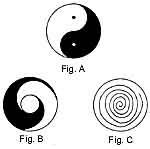Taoism > The Basics
About Yin and Yang
(Short history and meaning)
 |
There's a huge interest in the yin-yang topic. This is partly due to the fact that yin and yang reminds one of a concept hold dear by Westerners: complementarity.
Chinese culture is fond of yin-yang concept. We find it everywhere and its use is practically unlimited.
In Shambhala Dictionary of Taoism we read that yin and yang are "two polar energies that, by their fluctuation and interaction, are the cause of the universe". (p. 216).
So they seem to be basic principles or forces that produce what we call "universe".
Yin and yang appear in the commentaries on
I-ching (Book of Changes) as well as in the Spring and Autumn Annals, over 2000 years ago.In I-ching, yin and yang form the trigrams, more precisely the component lines, ___ and _ _, that further form the hexagrams, the core of the Book.

In Annals, we find that yin and yang "separate and merge again". This recall the Shambhala definition of interacting polar energies. In the Chinese classic medicine yin and yang refer to energies and functioning modes of organs and body. It is said that the healthy state is brought by the right balance between them.
Yin and Yang stages of interaction |
But yin and yang may be also features referring to people, things or cosmic phenomena. We find lists of these features in the Western books and magazines.
Let's conclude with
Alan Watts that the yin-yang ideograms:Indicate the sunny and shady sides of a hill, and they are associated with the masculine and the feminine, the firm and the yielding, the strong and the weak, the light and the dark, the rising and the falling, heaven and earth... (Alan Watts, Tao: The Watercourse Way, Pantheon Books, 1975, p. 21).
Further Resources:
here to learn more.
Read about:
Articles - CoursesPaperstore - Bookstore - PDFResources - Abstracts - DictionaryForum Newsletter - Search - Contact
Copyright Way of Perfect Emptiness, 2025. All rights reserved.
![]()
